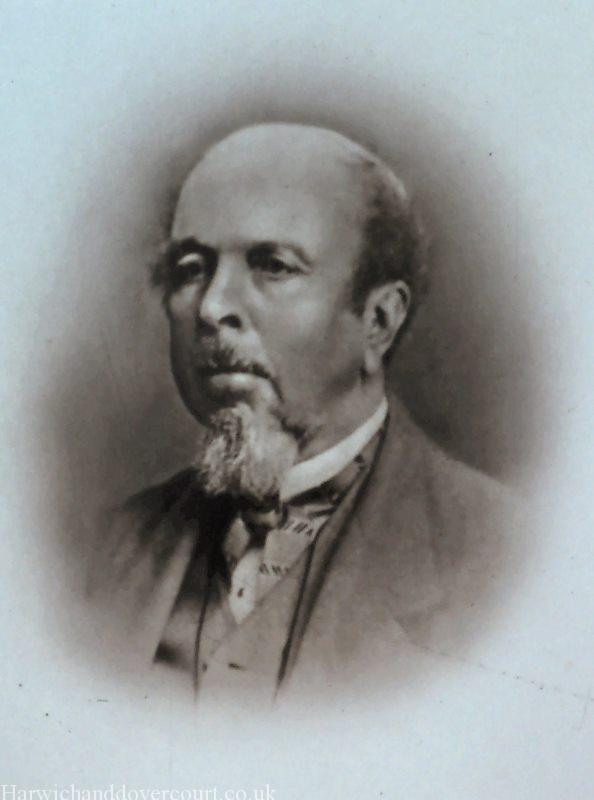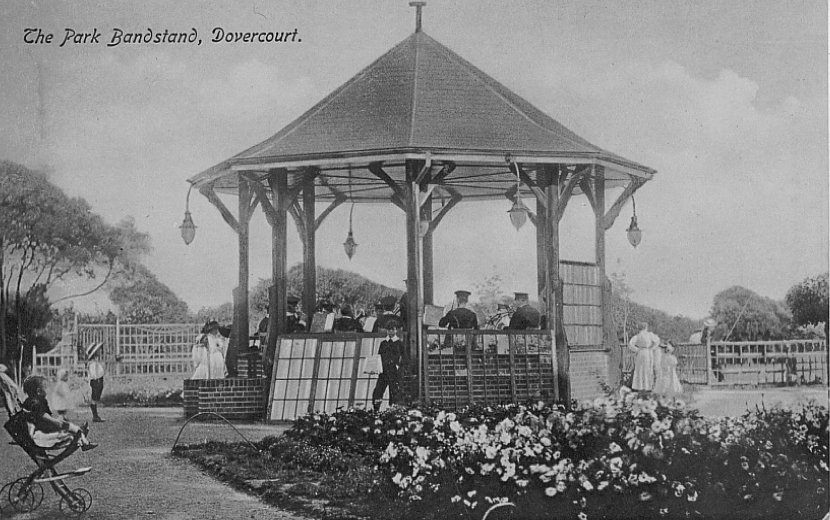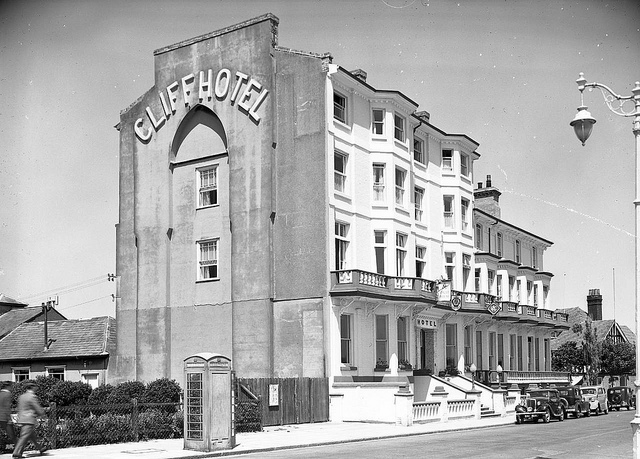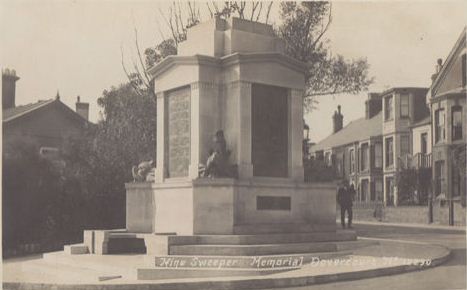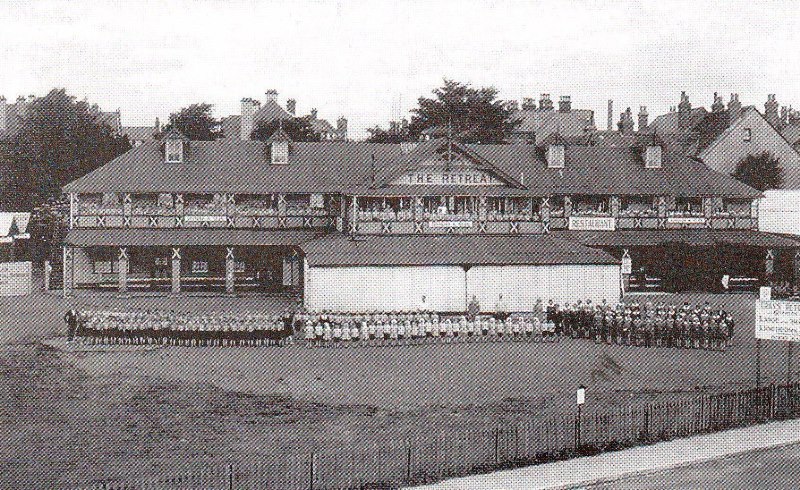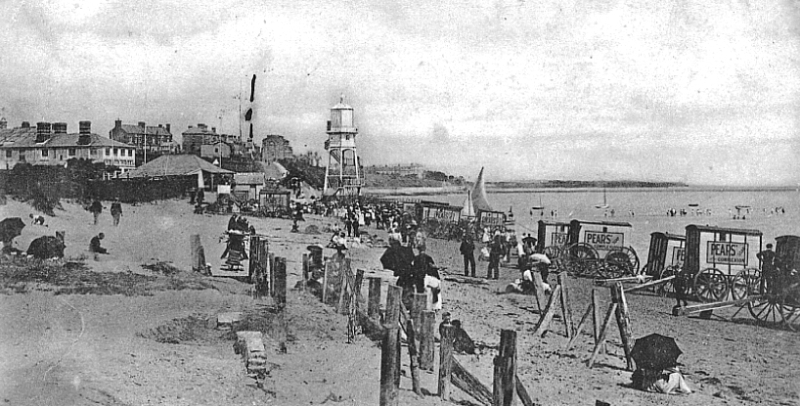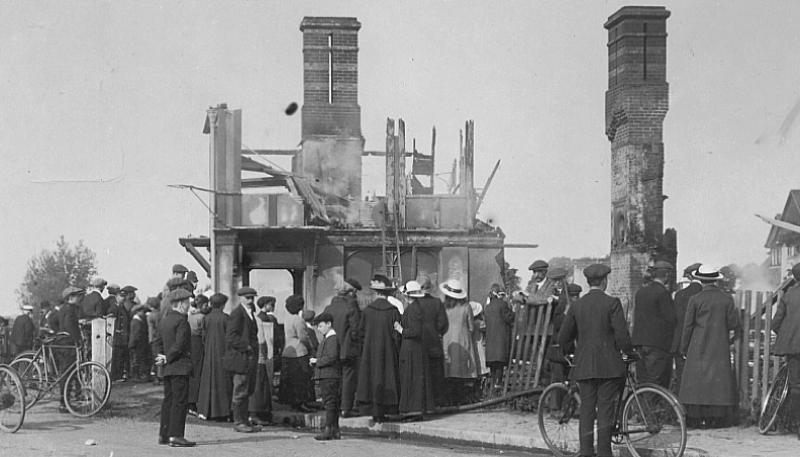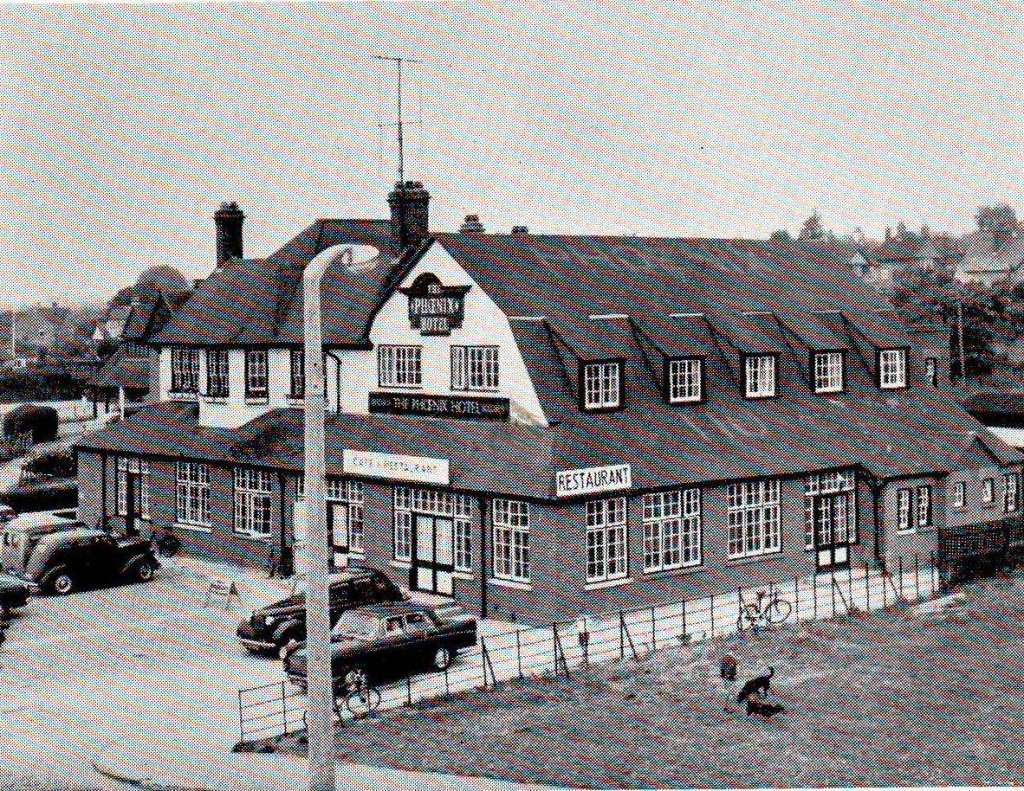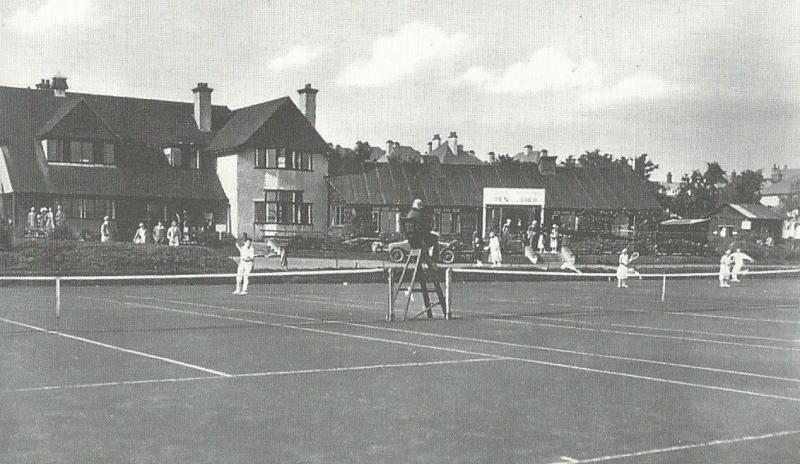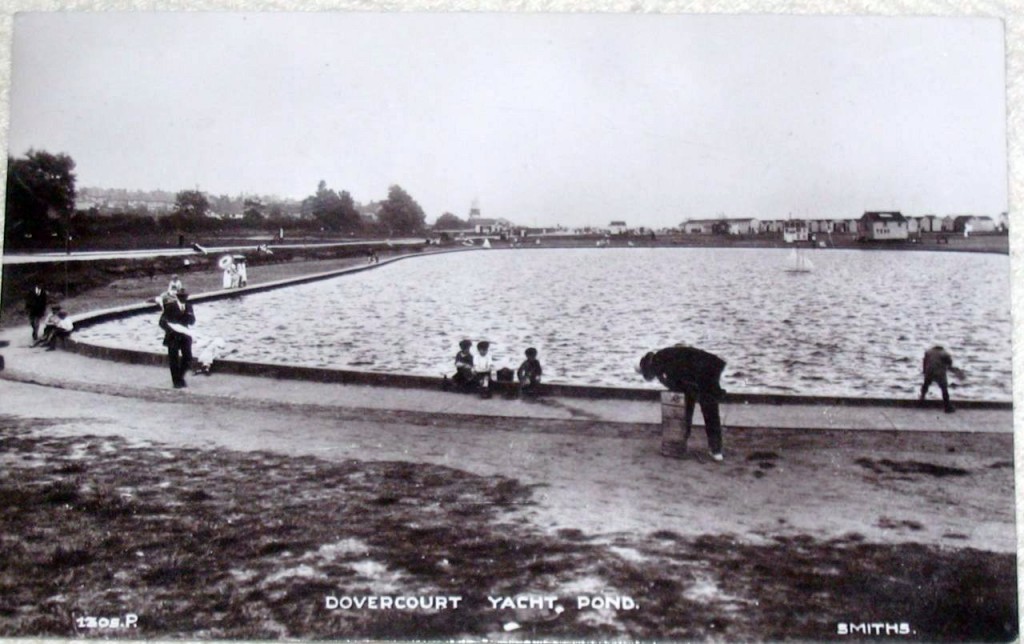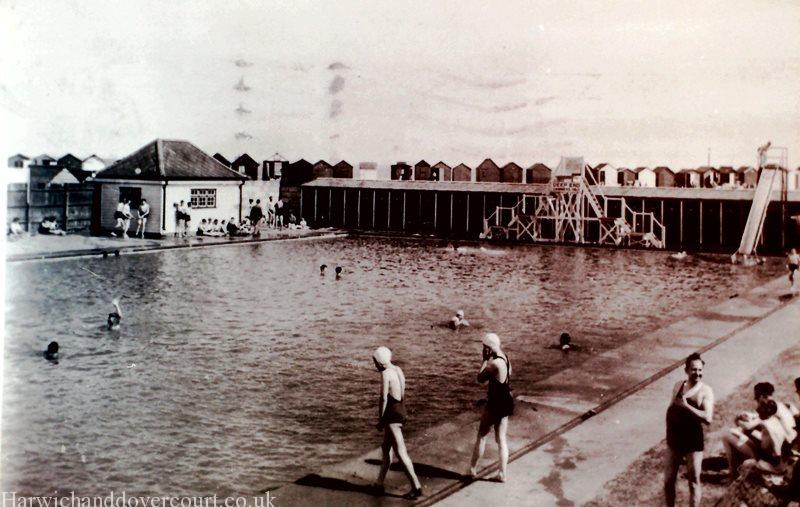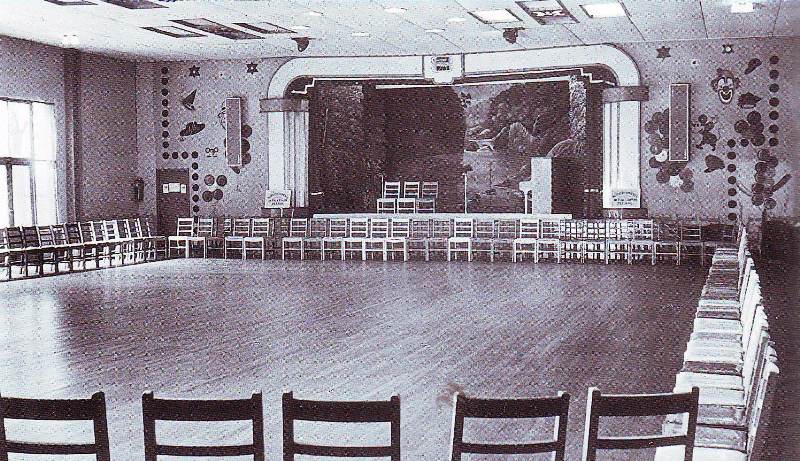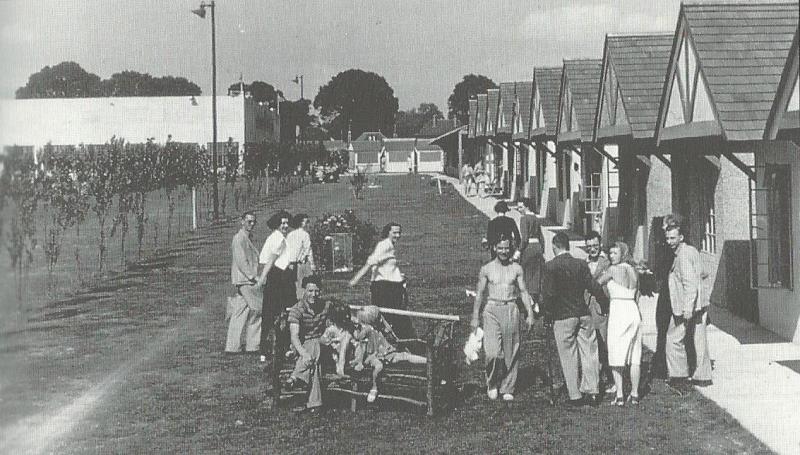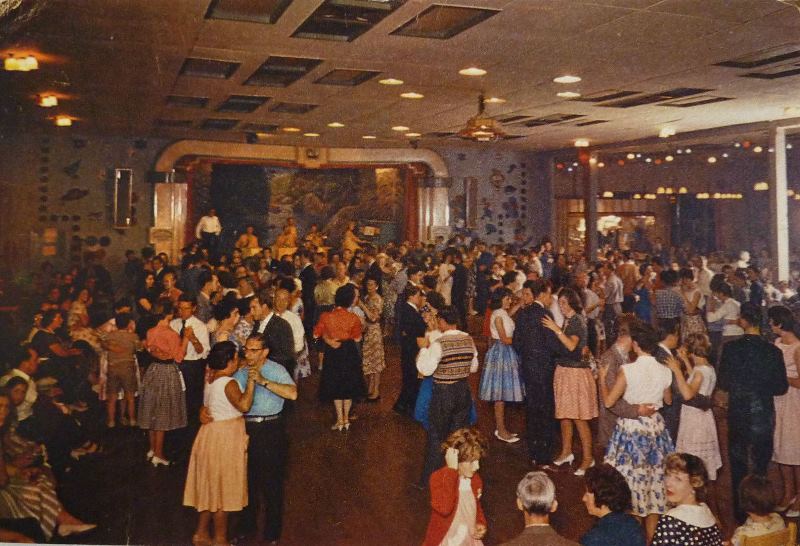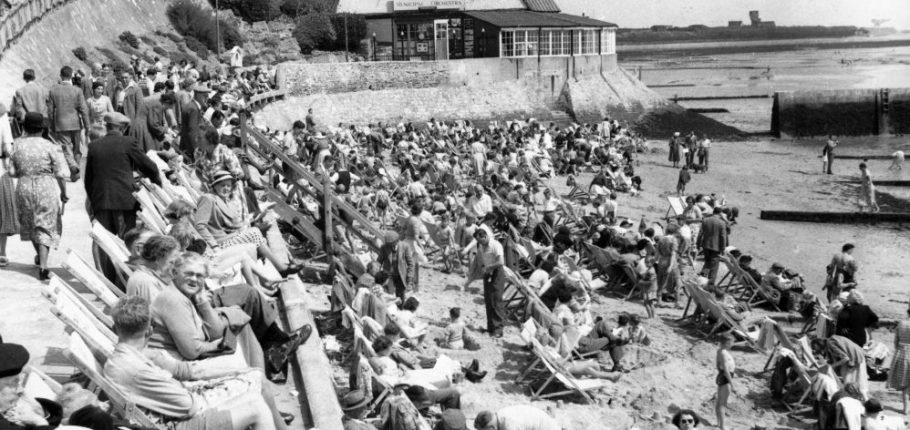
Dovercourt Bay
A Seaside Resort
On the cliffs of Dovercourt, facing the North Sea, is the beautiful view of Dovercourt bay, which is about a mile from old Dovercourt, and the same distance from the port of Harwich, a fashionable and delightful seaside resort has grown, the sea and land views can be compared to that of the bay of Naples, on the left you have lovely views of Felixstowe, Languard and Harwich forts, with shipping entering the harbour. On the right Walton on the Naze in front a constant panorama of ships passing north and south on the German Ocean.
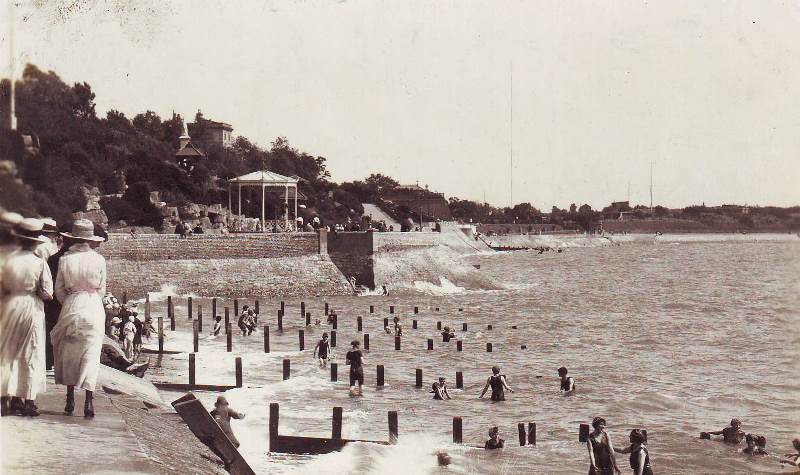
Dovercourt Bay
Let us, in imagination, take you and your family for a summer holiday at Dovercourt Bay, a holiday Never to be forgotten for the wonderfully happy time you all spent. What is it that attracts the holidaymaker, the seeker after health and happiness, to this Tiny beauty spot tucked away in one of the many inlets of the East Coast. Picture a brilliant summer day with the great North Sea rolling leisurely on to a stretch of Golden beach. behind, green slopes rise up with their dainty walks and picturesque flower beds, while below a promenade stretches like long white ribbon far away into the distance, where It merges with the green charm of the countryside. a cool and gentle breeze stirs the calm of the wavelets, sparkling in the bright sunlight, while the soft clean air refreshes the bronzed and happy crowds who are sport themselves in their various ways.
Before the days of the motor car holiday makers flocked to Dovercourt by rail and sea. at weekends steamers from Ipswich were packed, and in summer there was a daily service between London and Yarmouth, calling at Southend, Clacton, Walton and Harwich. Some visitors stayed at hotels and guest houses, while others found lodgings in roads near the area, they spent most of their time on the beach, where they paddled, played games and joined in sand castle competitions.
This brought developments at Dovercourt mainly due to the initiatives of John Bagshaw, a former East India merchant who settled in Harwich, who took over the ship yard, and planned to build a new town at lower Dovercourt. He began in 1845 by building a mansion, Cliff House, in the grounds which had become Cliff Park. After his election to parliament in 1847 he took an active part in bringing the railway to Harwich. At the same time W.H. Lindsey, a London architect produced plans for Dover Court new town, and when a chalybeate spring was discovered in the grounds of Cliff house, Bagshaw built the spa which opened on the 28th August 1854 and incorporated a library, pump room, and a conservatory which was used as a reading and smoking room. The first building was Orwell terrace which Bagshaw’s son Robert took up residence at Banksea house at the seaward end in 1857.
The slopes from Orwell Terrace to Mill Lane were landscaped, with a grotto, shelters and a Miniature waterfall, but this costs over £ 10,000, and John Bagshaw was in financial difficulties. He completed the construction of Marine Parade and the Cliff Estate, but he was adjudged bankrupt in 1859.
He died in Norwood in 1861 after the contents of his house and the Spa had been sold and his estate broken up. After remaining empty for some years Cliff House was demolished in 1909, eleven years later the Spa suffered a similar fate.
Orwell Terrace, the east side of Cliff Road, The Cliff Hotel, the Queen’s Head Hotel, Victoria Street, the Spa and the circular facing Waddesdon road, were left to remind us of his grandiose plans.
Cliff Park
Cliff Park was opened in June 1911 as part of the Borough’s Coronation celebrations. A 300-yard Procession of local schoolchildren and local organisations must have had a marvelous spectacle, as people crowded the streets to watch. From Harwich to Cliff Road, on to the Marine Parade and back into the Park, the procession thrilled the watching crowds. The focal point inside the Park was the Bandstand. Some cynics pointed out that the money could have been better spent on a new fire engine! However, the Park would be enjoyed for many years to come by locals and also holidaymakers, which would create more income for the town.
The 2500 children then made their way to the Drill Hall for tea, a coronation mug and a box of chocolates.
The Elco
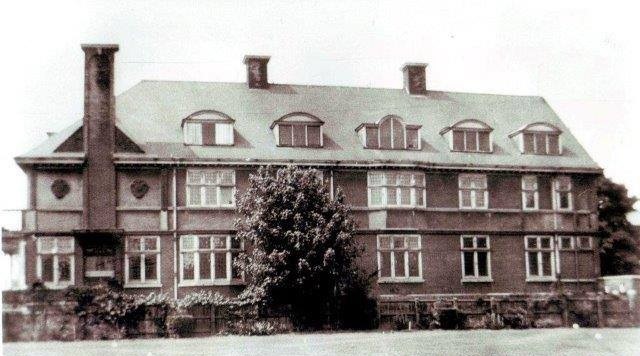
The Elco
The original building was built before the 1914-18 war as private house and during that war was used as naval convalescent home. In 1938 John Elliott purchased Cliff Hall and renamed it the Elco and opened it as a private hotel and café. At the start of the 1939-45 war it was used as a military headquarters and later utilised as sleeping and living accommodation for Wrens. The building was subject to an incendiary attack in 1940, which set the roof on fire and resulted in considerable damage to the second storey. It was repaired and then became briefly under naval control mainly being used for, the women’s royal naval service.
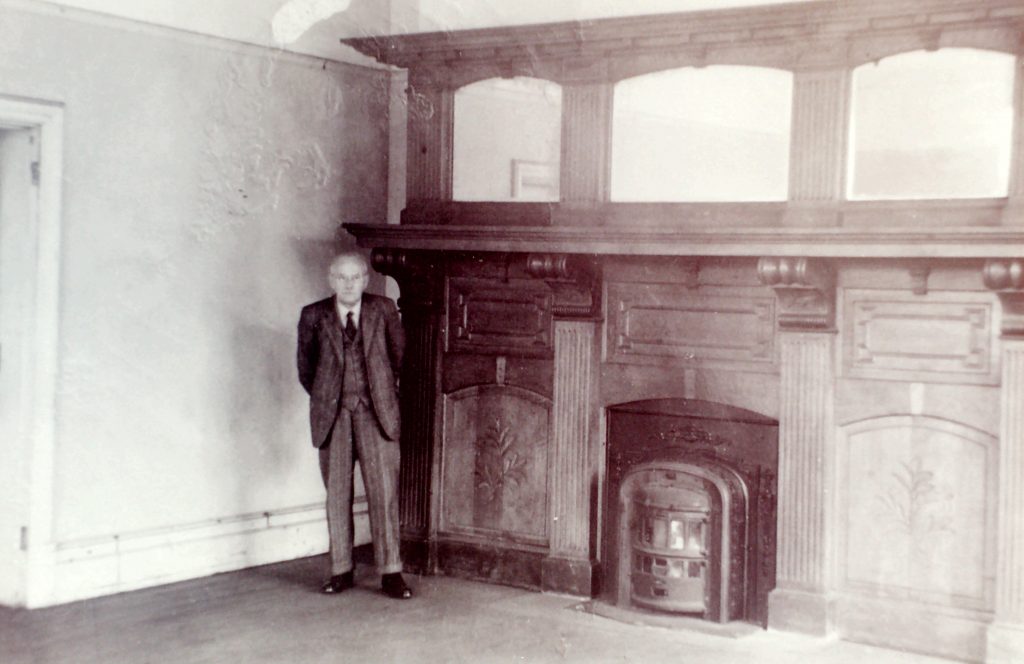
Mr John Elliot
After the late Mr. John Elliot, the owner partly converted the building into holiday flats but did not prove very successful and the building was demolished during the summer of 1972.
The Shaftesbury Housing Association built 23 one, and seven two-people flats on the site which would cater for pensioners from throughout the country.
The Alexandra Hotel
Officially opened on the 25th May 1903 with lunch for 120 guests entertained by a five piece Orchestra,the hotel was described as a ‘fine and handsome
hotel’ and a ‘handsome and palatial building’.Designed in the Queen Anne style by Sherrin and situated in 3/4 acre of land overlooking the bay, the driving force behind the hotel was Thomas Moran. The opening luncheon for 120 guests was entertained by the five ladies of the Nell Gwynn orchestra.
The entry for the guests was in Marine Parade, leading into the chief apartment on the ground floor, and out of which a handsome oak staircase gives access to the 40 bedrooms and the suite of rooms above. A feature in the Alexandra Hall, which is a bijou theatre fitted up in the most modern style and capable of seating 500 people. In addition to the dining, drawing and billiards rooms on the ground floor, there is a restaurant which can be entered both from within the hotel and from the street entrance.
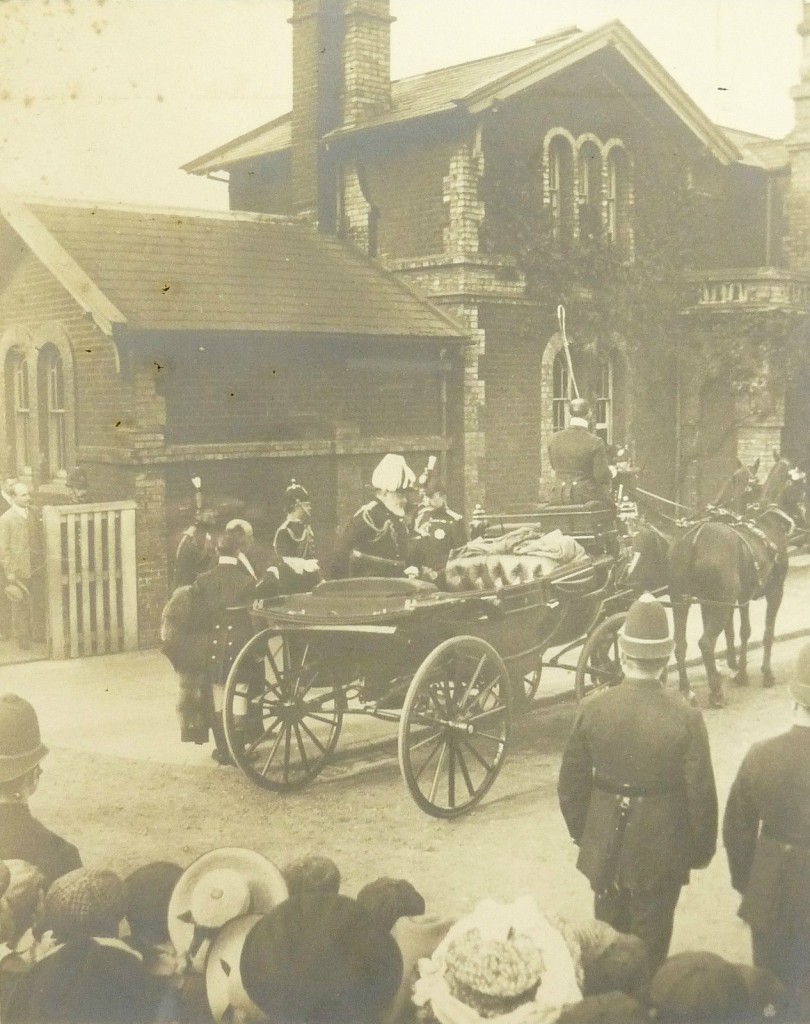
King’s visit 1905
On 19 May 1905, King Edward VII visited Dovercourt. The main purpose of the visit was to inspect the local militia. In the evening before returning to London, the King had dinner with his officers in the Alexandra Hotel, now Alexandra House. In recognition of the 100th anniversary of this event, on 19 May 2005, Alexandra House had a small exhibition in the home to recall the King’s visit, and they replicated items from the menu served to the King for the residents’ lunch. The advent of the First World War saw the stationing of many Royal Navy warships in Harwich Harbour and the Alex became famous as the meeting place for officers and often accommodated visiting wives and families. Many subsequently came back to Dovercourt for their summer holidays, enjoying the delights of the season with the Band Pavilion’s concerts, playing tennis or bowls and attending dances and entertainments in the theatre.
The Second World War saw the destroyer fleet back in Harwich. with Wrens stationed at the Elco there was always a lively atmosphere in the Alex. each week dances were held to raise money for charities. Despite the gloom and anxiety of war and the danger of air attacks, the dances went on.
In 1959 the then owners Charringtons Brewers sold the hotel to MHA and Alexandra House Care Home opened in 1962. It was home to 27 residents for nearly 50 years but work began in October 2009 to build a new home in the grounds to add a further 46 rooms, 15 of which now enable us to cater for residents with dementia and high dependency. After residents were moved into the new building on 1st July 2011, work began to redevelop the old building to provide 14 luxury one-bedroom flats and studios. The location offers panoramic views of the sea front and several residents have the privilege of rooms with a sea view.
Queen Victoria’s Statue
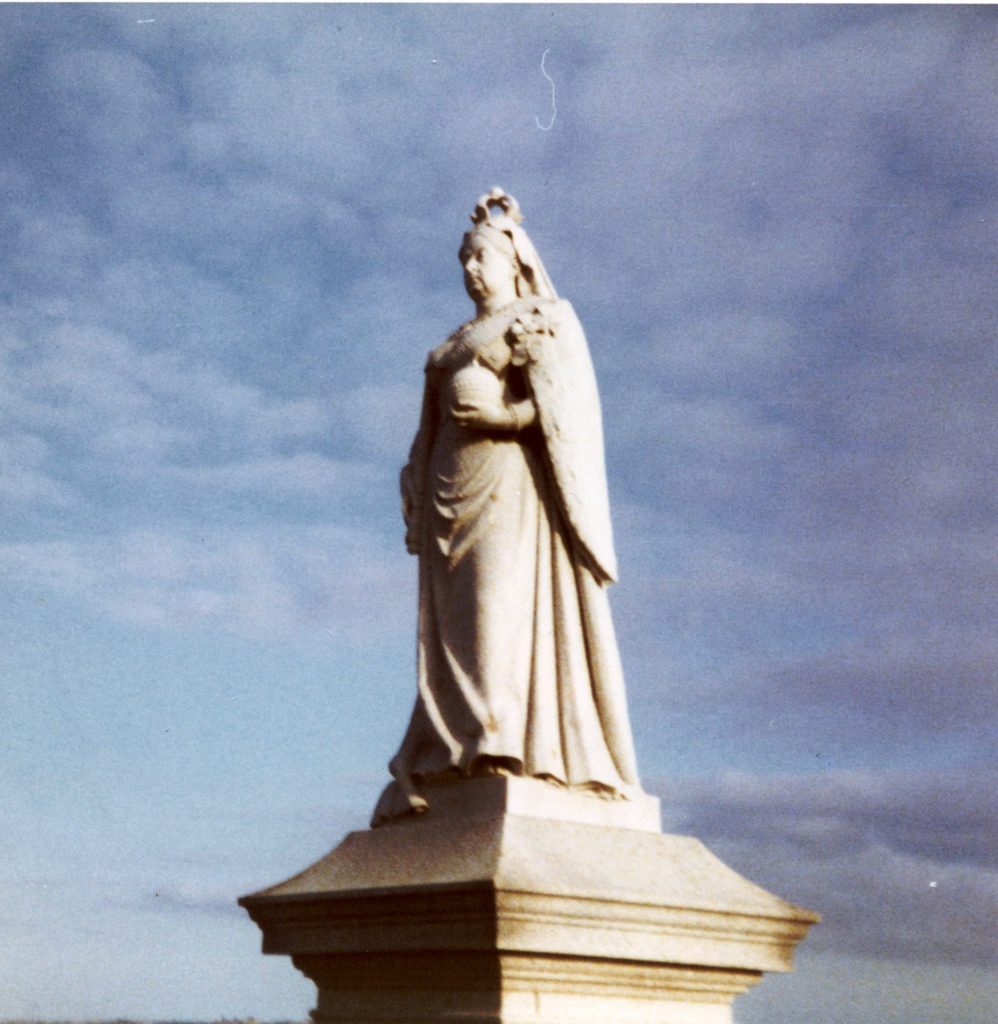
Queen Victoria’s Statue
This monument, possibly Dovercourt’s most famous landmark, was unveiled on Saturday June 11th 1904 by the Earl of Warwick, dedicated to the memory of the beloved Queen Victoria who had died three years previously. The money to pay for the memorial was raised by public subscription and it was designed and constructed by Watts of Colchester. Fourteen feet high and weighing almost 9 tons, the memorial was made of Carrara marble on a Cornish granite base. June 11th 1904. There was a large gathering at Dovercourt on Saturday afternoon of residents within the ancient borough of Harwich and visitors to witness the unveiling by the Earl of Warwick, Lord Lieutenant of the County of Essex, of a statue of the late Queen Victoria which has been erected by public subscription on the Marine Parade. The site of the memorial has been well chosen, being the entrance to “King’s Way, in the Dovercourt pleasure grounds nearly opposite the Alexandra Hotel.
Programme of events, 4.40 pm a Guard of Honour provided by the 1st Suffolk and Harwich RGA, with band, to assemble and take up their places to the right of the statue.
At 5pm the Mayor, Magistrates, and Corporation will take up their place to the immediate right of the statue.
At 5.05pm, the Lord Lieutenant of the County will arrive and be received with a general salute.
The Earl of Warwick. who was the Lord Lieutenant of Essex, arrived at 5pm to perform the unveiling and inspeered a guard of honour of the Suffolk and Harwich R,G.A. An enclosure was put up opposite the Hotel Alexandra for the invited guests.
For over 100 years the Queen has cast her eye down Kingsway and no visitor can fail to notice the imposing figure.
Cliff Hotel
Delightfully situated facing the sea, open throughout the year. First class accommodation and service. Tea Garden hot & cold water in every bedroom. Built in 1850 as 2 houses and purchased by Daniels, brewers from West Bergholt, the Cliff Hotel was created in 1870.
In 1882 Victoria hall, was built as the Cliff Hotel Pavilion, the Southside of the hotel was converted into Palais de Danse ballroom, the billiard room was converted into a café lounge. This project opened in 1924. A lounge between the reception lounge and the saloon bar, became the new billiard room, the following year the café lounge was integrated into the dance hall.
The local newspaper reports: July 18 1925.
With the advent of the summer season, the Palais de Danse is rapidly becoming one of the most favoured of resorts, in Dovercourt, for lovers of the delights of dancing. And rightly so, for here are to be found all those necessary adjuncts to the proper enjoyment of the fascinating and increasingly popular pastime.
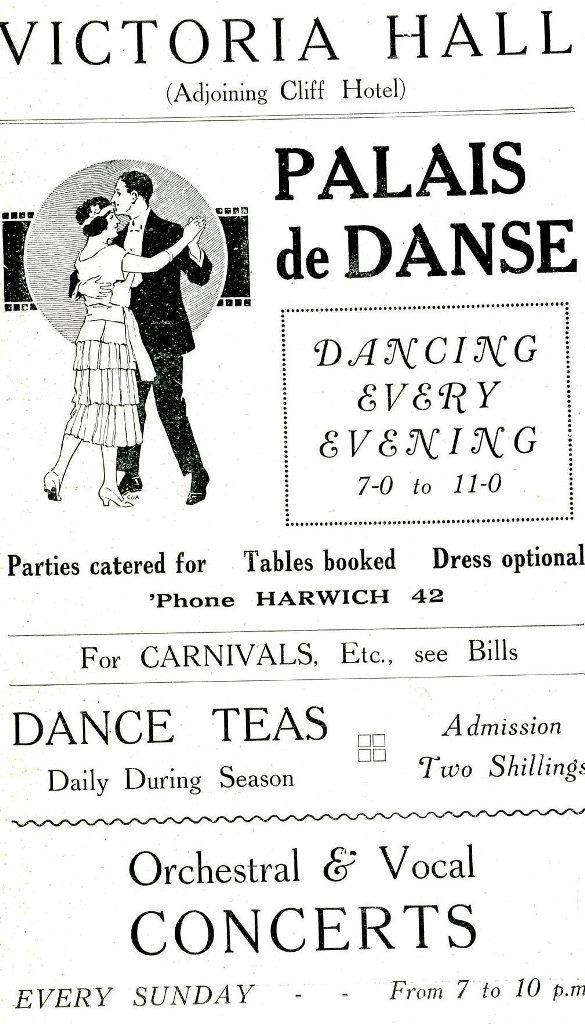
Palais de Danse
Allied to a perfect floor is a dance orchestra, the members of which know to a nicety the requirements of dances and frequent encores testify to the ability to please with their renditions of the latest London dance successes.
The Dovercourt Minesweepers Memorial
Unveiled on 20th December 1919 and is dedicated to officers and men of the Royal Naval Reserve, Royal Naval Volunteer Reserve, Auxiliary Reserve and Minesweepers. The dedication reads: To the Glory of God and in proud memory of the officers and men of the Royal Naval Reserve & Royal Naval Volunteer Reserve serving in the Auxiliary Patrol & Minesweepers at Harwich who died in the performance of their duties that the sea might be made free Twilight and evening bell, and after that the dark! and may there be no sadness of farewell. When I embark; for tho’ from out our Bourne of time and place the flood may bear me far. I hope to see my Pilot face to face, when I have crossed the bar.
Donkey Rides
This photograph shows the donkeys, at the bottom of Beach Road. The owner of the donkeys was Jim Osborne who also used to run a landau taxi service between Dovercourt Station and the beach with his brother. Mrs Osborne then continued the business into the 1920s living in a cottage next to All Saints Church and keeping the donkeys in adjacent fields, where Portals factory now stands. The young lad has his ‘persuader’ – a stick – to persuade the sometimes stubborn donkeys to go about their work.
A penny was charged for a ride to the foot of the hill and 2d to the top of the hill where the Minesweepers Memorial stands. Extra was charged if the parents wanted a photograph of their children. During the winter the donkeys we re stabled at Bradfield next to the Ram and Hoggett – a long walk for bath the donkeys and the lads who took them there and then had to walk back.
Band Enclosure
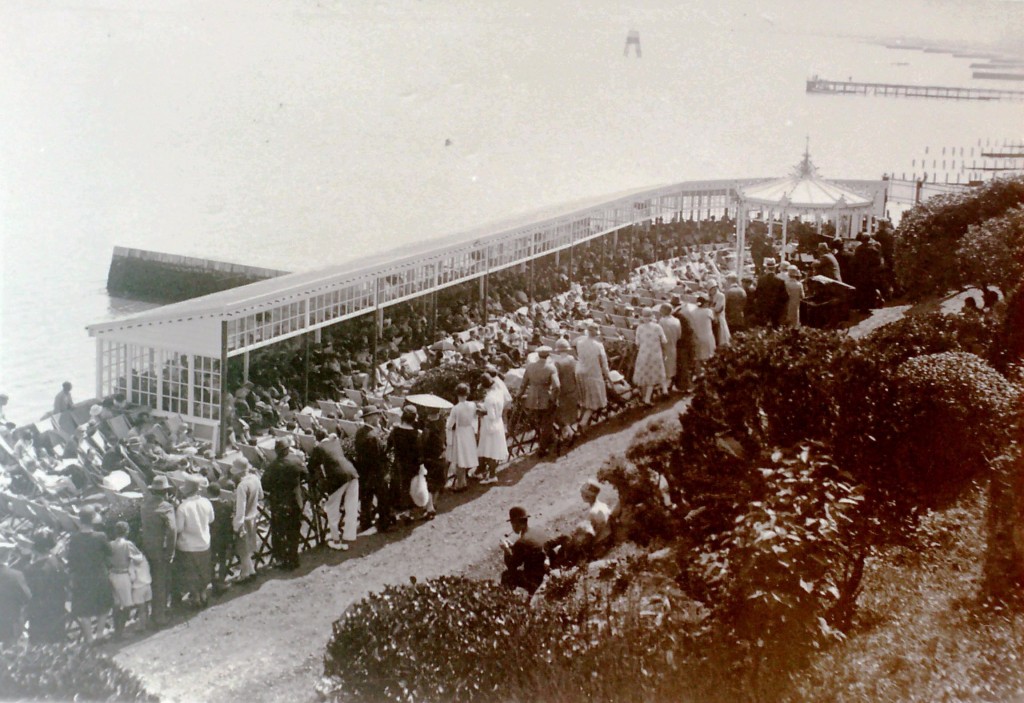
Band Enclosure
The Bandstand was given to the town by the Co-operative society in 1901, and for some years thereafter concerts were given by many different bands, including those of the Harwich Volunteers, regiments stationed at Colchester, H.M.S. Ganges, and the Brantham Xylonite works, In 1904 the council bought 200 deckchairs and engaged Mr Lindon Watt of Manchester and his band to play for a period of seven weeks, giving two performances daily, except on Sunday. His pay of £10 per week was supplemented by collections taken at the performances.
In 1929 further protection was provided for the band and a good number of those who came to hear music by building a sheltering wall on the seaward side, but no-one was entirely protected if the weather proved inclement.
The new shelter is built on the existing sea wall, the bottom cells being firmly held down by iron dogs and supported by high channel stanchions. It is practically a glass shelter, supported by teak posts and has seating accommodation for close on 300 persons, and providing shelter accommodation for more than twice that number when the band is not playing. There is a pay-box at the west end and ornamental gates at either end, surmounted with Flambeau globes. Every section of the shelter has been fitted with electric light and fairy electric lamps adorn and front of the shelter. From any part of the shelter, when the band is not playing, visitors can obtain a delightful Picturesque and panoramic view of Dovercourt bay.
Standing prominently on the sea front. the Pavilion is laid out on the lines of a Central European Casino Winter Garden, the danger that the cliff might slip caused the council to undertake a major scheme of coast protection at Dovercourt. Although the 1901 erected Bandstand had proved very popular, listeners were subjected to cold sea winds. A glass-clad enclosure was built along the sea wall and was officially opened on the 14th July 1929.
THE NEW BAND PAVILION
An opportunity to enjoy good music in the most pleasant surroundings and in the greatest of comfort is an attraction which Dovercourt offers both its visitors and residents.
This is made possible by the opening of the new covered band enclosure on Dovercourt’s sea front, which marks one of the biggest steps in Dovercourt’s progress in the matter of catering for amusements.
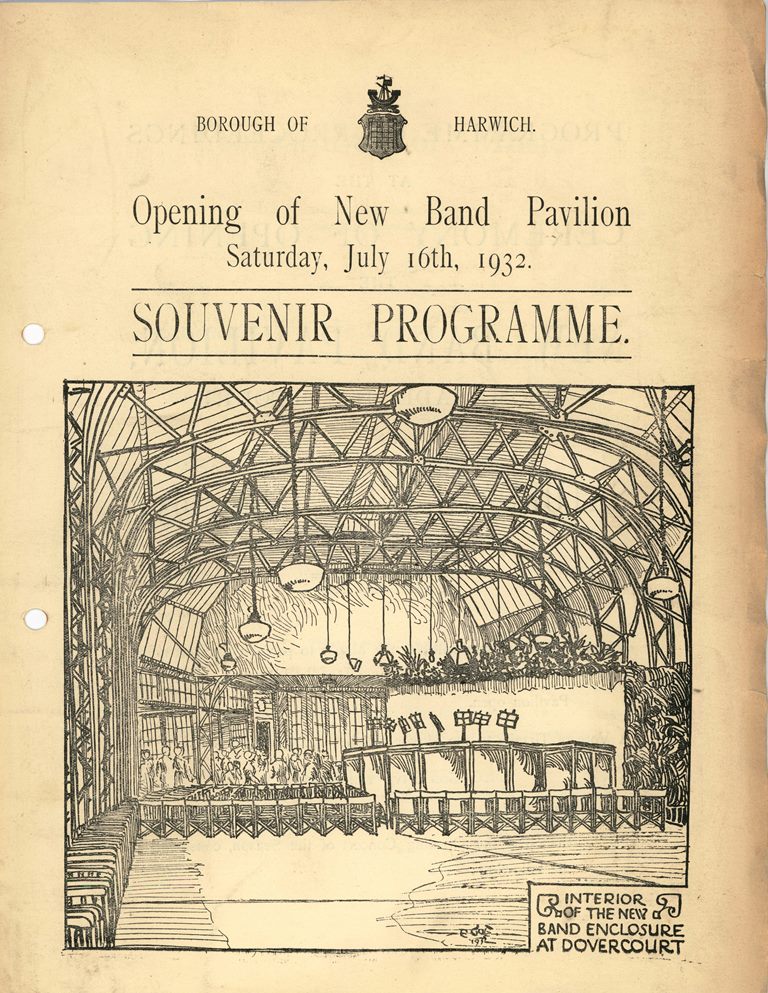
Souvenir Programme
The making of the totally enclosed band pavilion was no simple problem for the Corporation to solve. Indeed the site was one which could not be easily dealt with, when conditions generally made the Council wary on any large capital expenditure.
However, the Corporation considered schemes and wisely chose the one which has now been completed.
The new pavilion is constructed of semi-circular steel trusses which reach over from the old shelter to the cliffs. These are covered with glass, while there is a flat asphalt top, mounted by a lantern light. The new part of the pavilion is 54 feet wide at the widest part, narrowing to about 24 feet. It is about 126 feet long and 23 feet high to the underside of the roof. The lantern light I 6 feet wide and 80 feet long.
As a result they have a fine, airy, attractive pavilion, providing seating accommodation for over 800, close by the sea, and all for a cost of a little more than £2,200.
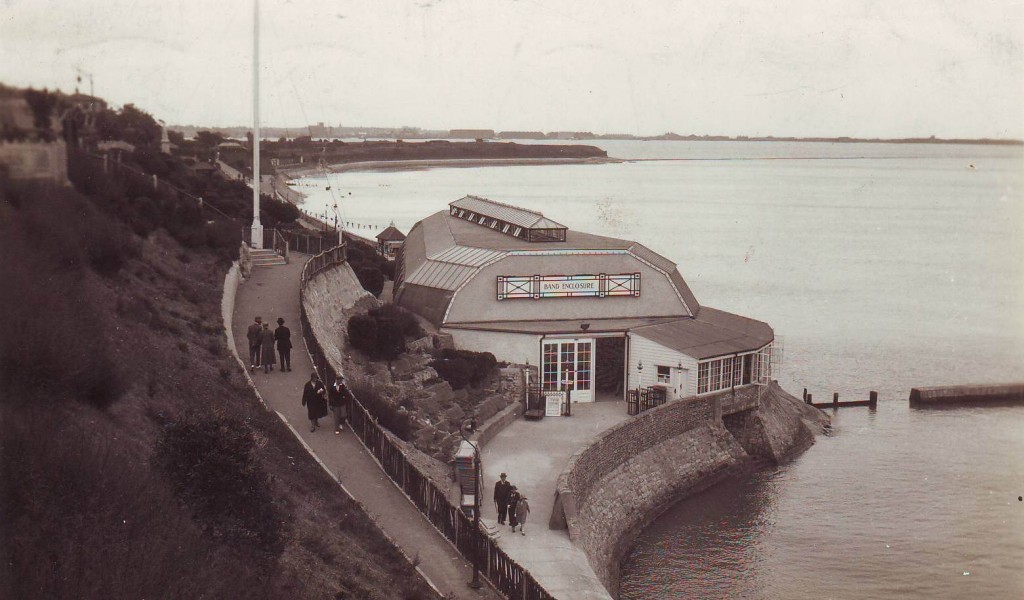
Band Pavilion
Performances within the Band Pavilion were many are varied. 300 people could be accommodated with the audiences seated in different types of deck chair. Traditional dances were regularly held; well-known bands and orchestras were brought to Dovercourt as one-offs or for the season. Local talent contests were held, along with children’s entertainers and competitions for children.
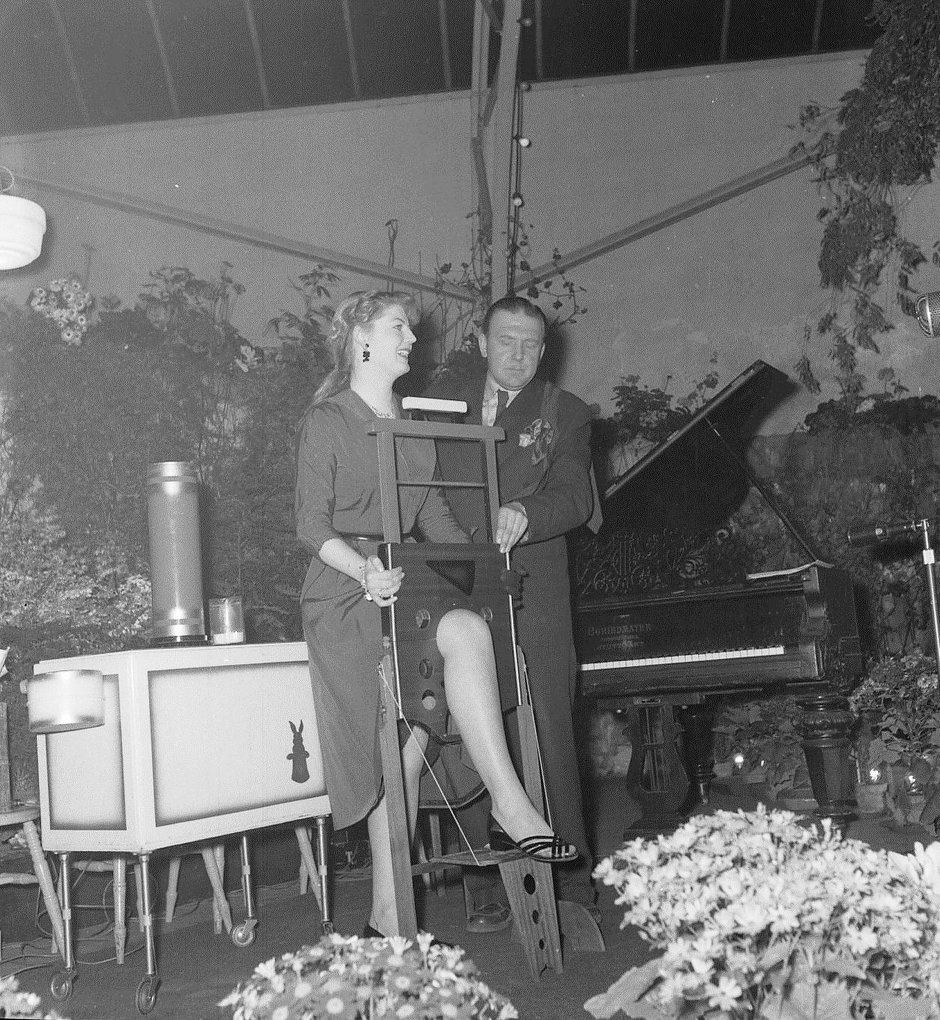
Cliff Pavilion
Even indoor bowls was introduced in 1938. Perhaps the highlight was the broadcast by Wilfred Pickles and Mabel from the pavilion in 1957. Many people were sad to see such a local landmark disappear with nothing tangible to replace it. The Cliff Pavilion tried to entertain all age groups and all interests. One of the interests catered for, during the winter season, was bowling, to complement the facilities available during the summer.
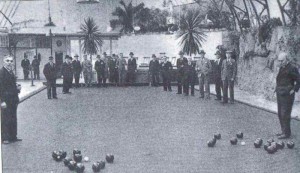
Bowling 1938
This posed picture shows the opening of the indoor bowling mats with an inaugural roll up between the Mayor and the Deputy Mayor in 1938. Dovercourt also boasted a ‘pretty green adjoining the Alexandra Hotel’, but also had the ‘excellent bowling green’ of the Dovercourt Bowling Club. This was claimed to be the principal feature of the district, having six rinks and being open to visitors for a nominal charge. All that had gradually died out.
Now the visitors came down for the day in their cars bringing their own food and deckchairs and grudging a fee to park: or they came to the holiday or caravans camps, where they found their own entertainment and annoyed people by riding up and down the prom- which was prohibited- on funny bicycles made for two.
It was a good job that the demand for rooms and meals had fallen off, for times had changed since the 20’s and the landladies of Lee road were no longer ready to work all the hours god sent and live in the shed while strangers occupied their beds just to make an extra pound or two.
Holidaying in Britain was starting to become less popular, and after cracks started to appear along marine parade in 1970, the council decided to allocate £ 580,000 to build a new promenade further out to sea and landscape the cliffs, sadly this required demolition of the Cliff pavilion and the Gables hotel in 1972. The Cinemas hadn’t felt it worthwhile to keep open. attendances began to decline T.V. finished them and, one by one, the three cinemas in Dovercourt followed by example of the Electric Palace. the Empire in Kingsway made room for shops; the Regent became a warehouse, and the Regal, a Bingo Club. The Alexandra Hotel, the scene of such splendour and gaiety in Edwardian days, became an old folk’s home-which some may think to have been a change for the better.
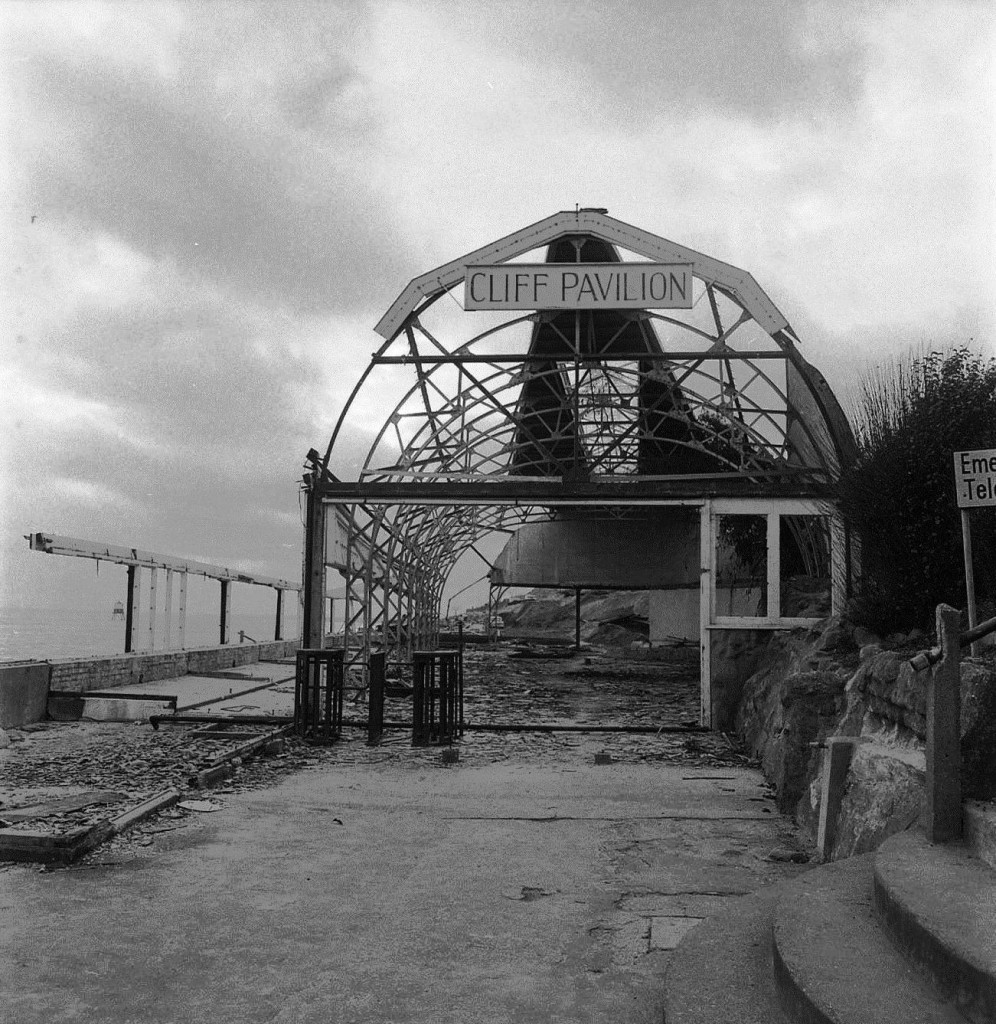
Cliff Pavilion (1973)
It was a relic of the days before the War when people came to the seaside for a week or so and the council engaged a seasonal manager to cater for their entertainment with an orchestra, Vocalists or Entertainers, fun for all the family on Friday night “Party night” – and a dance on Saturday.
The Retreat
The Retreat, built almost opposite to the
Dovercourt lighthouses in 1889, was owned by J.T.Riggs and it later became famous as Gray’s ‘temperance’ Retreat. The two storeys could accommodate 2,000 people, and was predominantly wooden, and had a restaurant and dance floor, which could also be used for roller skating. Sunday School outings and groups of children from London County Council schools slept in the long dormitories of the Retreat and usually brought their school bands with them.
In August 1923, children from the Guardians School, Islington stayed at the Retreat and entertained locals and visitors by performing in the grounds at the front. At one stage, whilst the Fire Brigade were fighting the fire at the Phoenix, the wind changed direction and there was a danger that the Retreat might go up in flames as well. The ‘aerial railway was alight’ and destroyed. The Helter Skelter, also caught alight, but, on this occasion, the prompt action of the local brigade saved it from any permanent damage.
The main function of the Retreat seems to be to provide accommodation and meals for parties of schoolchildren from the London area and could handle up to 250 children at a time. It also advertised visitors’ board residence from 2 ½ guineas per person per week. It is also claimed that, in the 1920’s, the Retreat boasted the two best billiard tables in town. The building was taken over by the military in 1940 and Was purchased by Harwich Borough Council in 1947 and demolished later that Same year.
In the Eighteen sixties sea bathing was allowed only from bathing machines near the phoenix. These were Covered wagons in which people changed and were drawn a short distance out to sea in order to enjoy a dip, far from public gaze. By 1912 bathing machines had gone out of fashion, and the landlord of the Phoenix put up twenty one huts where bathers could change into sufficient dress or covering extending from Neck to the knee.
Extracts from Fourteen days By the Seaside, By Maud Homer
Extracts from the diary of a 13 year old, written over 130 years ago. reproduced in their original spelling and punctuation.
Friday 1st September, 1865. After breakfast we went to the beach and after paying five schillings for one dozen bathing tickets we secured a machine which was let down into the water and Mary and I had a regular good bathe. I was in 2 minutes. Mary tried to swim and float much to our amusement. We find the smells from the marshes very disagreeable. Those closed our third day by the seaside.
Saturday, 2nd September, 1865. Everybody is social here the bathers speak. and smile to each other and warn one of the jelly fishes That Mary finds sting horribly.
Tuesday, 12th September, 1865. After breakfast we set off for the bathing, but found the tide very low, and so we walked Thro’ the blackberry lanes to Upper Dovercourt, and called at Mrs Johnstones as we meant to. We sat there some time, and saw her 11th child, a baby of 8 week’s old. When we came to the beach the tide was still out so I took off shoes and stockings and walked Out into the sea. Then we took a machine and all 3 got in, it was just over our ankles.
Bye Laws:
Although a holiday guide of 1904 proudly announced to visitors that mixed bathing was permitted, the bathing machines (owned by the Phoenix Hotel) permitted young ladies and women to bathe in modest seclusion, being lowered into the sea and raised again by the winding mechanism. Swimming was, therefore, relatively expensive and tickets could be purchased from the hut, but paddling was free. Bare legs and clothing well clear of the water were all that were required, and in the early years of the century this activity was the highlight of a seaside visit.
Phoenix Hotel
The Phoenix Hotel was situated almost on the beach at Dovercourt, with the popular
Dovercourt Sport Club-house and seven hard tennis courts on the other side, and the well-known visiting and dining rendezvous the Retreat on the other. The Phoenix was completely destroyed by fire shortly after midnight on Thursday morning 28th May 1914. The hotel was well-known to thousands of visitors to Dovercourt during the summer, and was also known as the comfortable residence of many visitors during the summer season.
The Hotel was the property of Messrs, Bullard and Sons, Norwich, and the tenant, Mr Everett, had been in occupation for six years, Mr and Mrs Everett had just completed preparations for the coming season, which was being looked forward to with confidence, indeed many of their rooms were booked for the holiday week. Police Sergeant Borrer who was on duty on the Marine Parade near the Alexandra Hotel, he had been discussing professional matters with a police constable, and just as he was dispatching him in the direction of Harwich he noticed smoke assuring from a house in the direction of the Retreat. The sergeant lost no time but acted smartly and opportunely, and it was fortunate. He sent the constable to the Alexandra Hotel to summon the Brigade, and he himself ran to the scene of the fire finding the outbreak and the Phoenix Hotel. Mr and Mrs Everett, their daughters, and the staff had all retired, and the police- sergeant found the Phoenix burning furiously, and the flames fast licking their way in the direction of the hotel, part of which was alight.
It was some minutes before the sergeant could rouse the sleeping inmates, and then Mr Everett and his family found that they had little time to make an exit from the hotel, and save a few of their more valuable articles of furniture, etc. It was an exceedingly narrow escape, and the sergeant’s promptitude was deserving of the highest praise. Sergeant Borrer and members of the family hastily removed such of their belongings as could conveniently be reached, and did not redound to the credit of several men who stood watching the fire that they took no heed to the cries and appeals for help from the Misses Everett.
The fire meanwhile “licked round the building like a snake”, to use the expression of one of the firemen, and the whole building was like a furnace. Happily the wind when the fire was at its height was in a south-easterly direction, and there was not the very grave danger of it reaching other buildings in the vicinity, but when the wind veered round to the north-east things looked much more ominous, and at one time there was some danger of the Retreat taking fire.
Various theories are advanced as to the origin of the fire. The police very emphatically state that the work of destruction cannot be laid at the door of the suffragettes, as many appear to imagine, for there is no trace of any literature, or anything that would in any way account for the outbreak as their handiwork. The best and most palpable theory appears to be that a quantity of rubbish had been burnt during the day at the rear of the premises, in proximity to the shed where the outbreak was first discovered, and that some had been left smouldering. This photo of the morning after the fire shows a close up of the remains of the Phoenix Hotel. The scene became a local attraction and everyone turned up to view the disaster. It became apparent that some rubbish was being burnt at the back of the hotel during the day. The seat of the fire was near a shed and it was near that the rubbish had probably smouldered all evening. Luckily the building was fully insured and was rebuilt.
The Phoenix was almost entirely a wooden building; In fact there was only one brick wall, so it was not surprising that the work and construction was very rapid. It is also interesting to remark that old Phoenix Hotel, which formerly stood on the same site some 45 years ago, was destroyed by fire, the tenant at the time being Mr Howard. Replacing the hotel of the same name destroyed by fire in 1914, the New Phoenix hotel facilities included, ground floor bar, open to the general public with a dining room/dance floor. On the south side was the main entrance and stairs to 13 guestrooms.
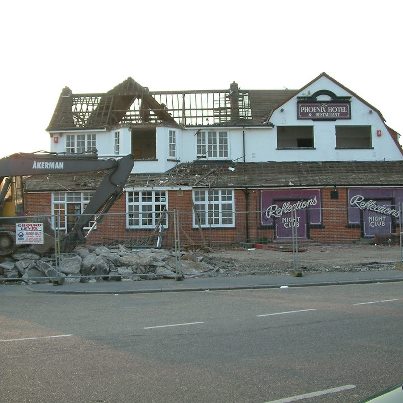
Phoenix Hotel
In 1985 the hotel was modernized, the two bars were converted into a single bar and the ballroom/dining room converted into a nightclub “Reflections” Sadly the hotel closed in 2003.
Dovercourt Sport Club (Squirrels)
Squirrels, as we knew it, was originally the Dovercourt Sports Club – Founded with the aim that its members would possess a club house and grounds for social and sporting purposes which will add greatly to the attractions of Dovercourt and to the pleasures of residents and visitors”. Under the chairmanship of Mr JW Carlyon-Hughes and on the 14th of October 1911 a site was purchased and the work of building a Clubhouse and the construction of seven tennis courts commenced.
The Clubhouse was designed by H Steward Watling and BJS Carlyon-Hughes, Architects of Dovercourt who designed many local houses, built by Blay Ltd of London and furnished by RD and JB Fraser of Ipswich. by 1913 the club had a membership of 250, on the 6th December 1922, the member agreed to take the club premises as tenants of the company which had founded it and to manage the club with their own committee.
In 1984 the club disposed of the lease privately and it continued to run the same way as previously with the exception that member no longer had any control in the day to day running and management.
For nearly 100 years, the club had served Dovercourt and Harwich as a venue for a wide variety of private and community functions.
Protestors battled in vain to save the old Squirrel’s Club before it closed in 2007.
Social club rises again
Today the former Squirrel’s club has been transformed into The Waterfront, the building stood empty for years and was branded ruin, but after a massive £1 million revamp the former Squirrel’s club has now reopened as the “The waterfront” which opened to the public on Friday 25th October 2013.
Owner Mr Clifton bought the site from the council in 2011 and has spent around £920,000 renovating the site, which has an events venue, bar and meeting room.
Roller Skating Rink
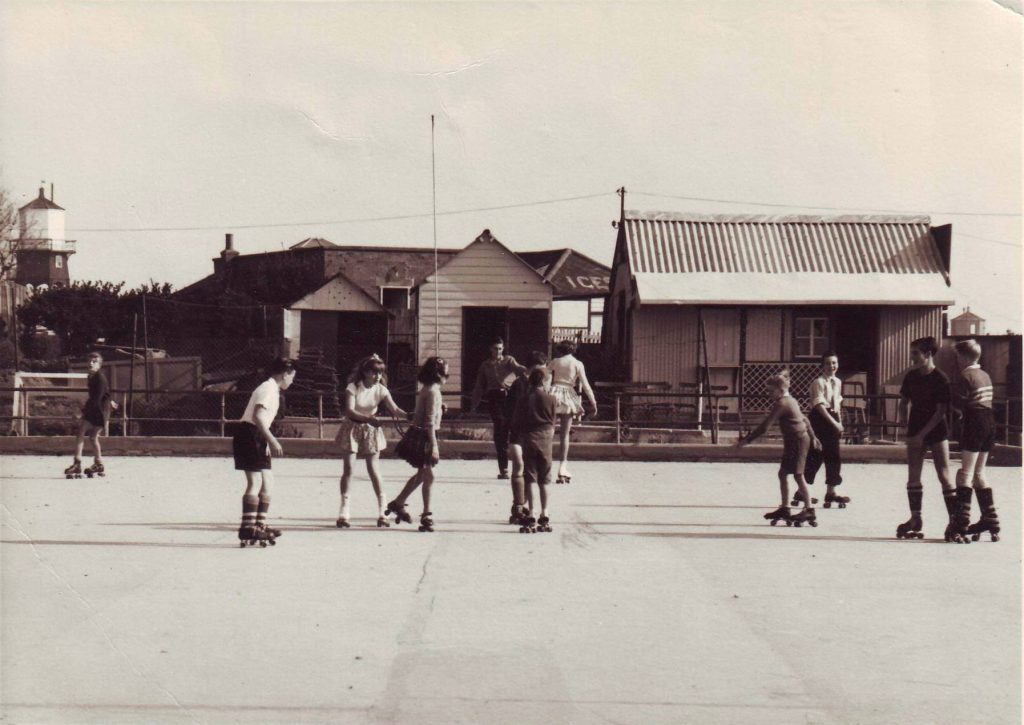
Roller Skating
With the Retreat past economic repair and it’s roller skating rink not Available for public use the council decided to build a new rink costing £1,800, officially opened on the 27th October 1947, after the ceremony professional skaters Harry Taylor and Barbara Hanson gave a display. Exciting international roller hockey match, the first to be staged at Dovercourt, was a feature of the programme presented by Dovercourt Roller Hockey Club on the Dovercourt rink, on Saturday August 27th 1966.
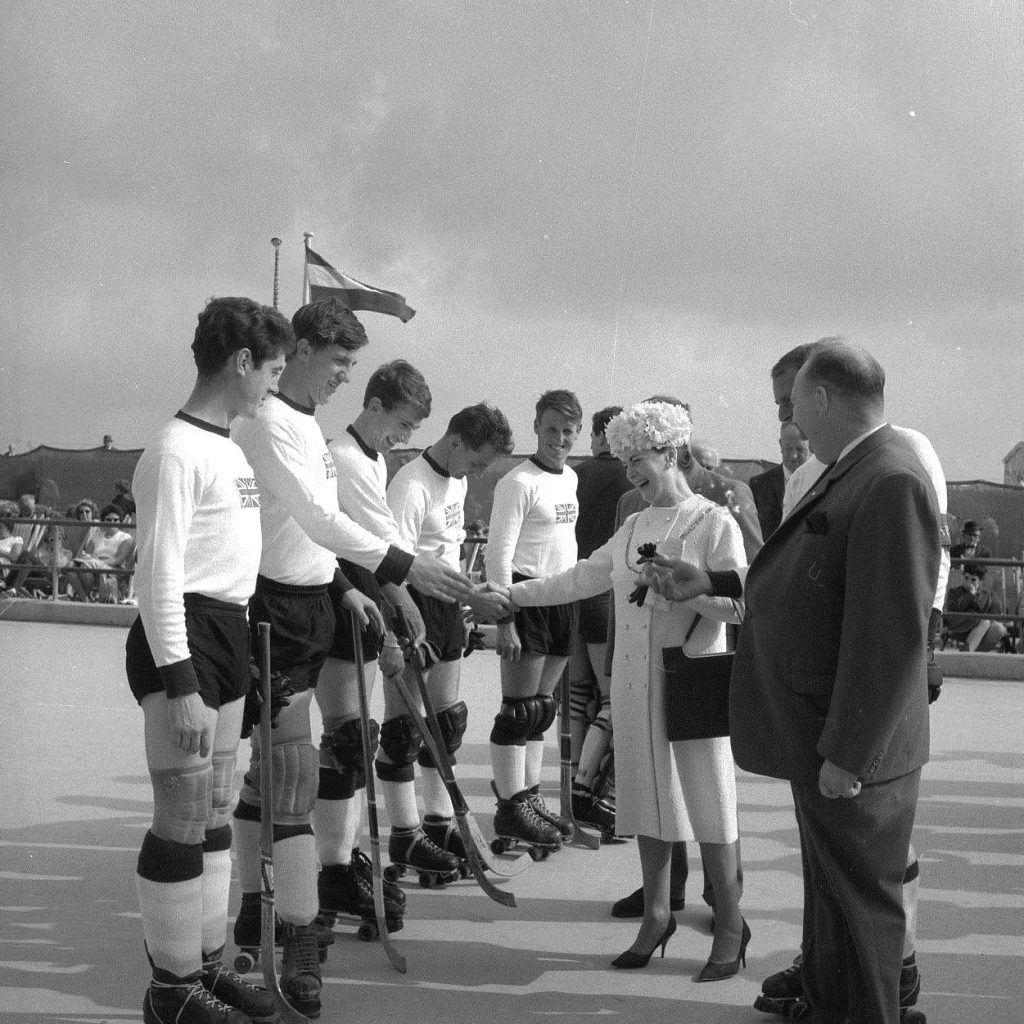
England v Holland
The high-speed game between England Holland resulted in a 4-4 draw, the first time the teams had met since Holland won in the world games in Brazil in May. Prior to the match a lunch was held in honour of the Dutch team at Phoenix Hotel. Guests included the Mayor and Mayoress, Councillor and Mrs L.E. Hostler, and Ald. E.Grant, president of the Dovercourt Roller Hockey Club, and Mrs Gant. Holland got the first goal after about ten minutes of the first half, and the second came a few minutes afterwards. Then England scored their first through A. Cattee, of Rochester. Holland were leading 2-1 at half- time, but England caught up again in the second half.
Ten minutes before the end it was 4-3 for Holland, then five minutes away from the final whistle B. Galloway, of Wolverhampton, scored a fine equaliser.
The rest of the show comprised colourful displays by young members of the Harwich and Dovercourt club, entitled “Tyrolean Capers” and “Toy Soldiers”.
In July 1973 the skating rink was officially reopened having been resurfaced and reduced in area setting it further back from the road, it was no longer Suitable for roller skating hockey.
Dovercourt Rink “Best in Britain”
The new rink on Dovercourt seafront is the best open air roller skating surface in Britain today. It was claimed at the official reopening of the rink on Saturday 7th July 1973.
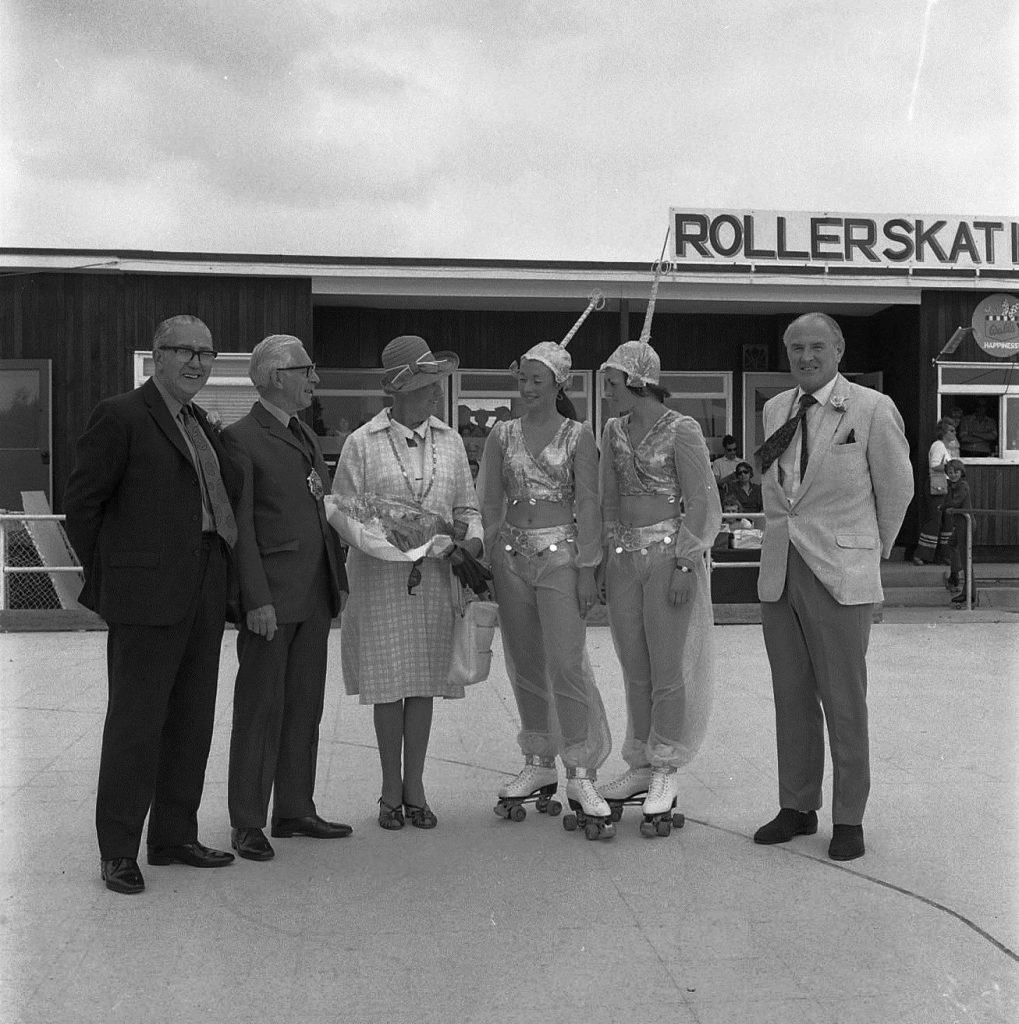
Re-opening 1973
The opening was followed by a skating display which included an interpretation of Tchaikovsky’s ballet Swan Lake to a taped accompaniment by member of the rink’s skating club, the youngest being just over eight. The leading parts were played by Susan Rumsby, who taught the skaters, Lisa Mudd, Susan James, Jane Every and Wendy Fisher. The scenery was made by Mr Len Barfield. The Mayor, in his opening speech, recalled that the rink had been built about 25 years ago on the site of some old tennis courts. He paid tribute to Mr Newbury, Mr Ted Stannard, the manager of the rink, Mr Barfield, and other enthusiastic members of the skating club who had helped to run the rink since then.
The 1940s rink at Dovercourt, Essex, reopened in 2010 after a revamp. But an out-of-court settlement after a customer was injured saw its insurance costs quadruple to £12,000 a year. Volunteer John Brown said hundreds of pounds were secured over the winter, which will now keep it open until a new £4,000 insurance year begins in March.
Dovercourt Skating Rink is one of the only ones left in the entire UK!
Model Yacht Pond
Harwich Town Council took full advantage of the Government’s attempts to reduce unemployment in the 1920s by claiming grants of up to 75% towards the work which went on in improving the sea front facilities at Dovercourt. The boating lake was built and leased to Mr J. Cann who opened at 8am and charged 6d per half hour per person. The model yacht pond, was very popular and opened in the same year and could be used freely by members of the public except when the Model Yacht Club was racing – Wednesday evenings and Saturday afternoons and evenings, The putting greens were added along with the tennis courts to add to the attraction of Dovercourt as a resort with plenty for the holidaymakers to do.
The Boating Lake
Looking from the boating lake, across the yachting pond towards ‘The Lane’ – no road through yet – in fact no building either, the house that can be seen was Wick Farm and was situated in what is now the grass car park, beyond the swimming pool. To the right is a small, white, milkmen’s cottage, behind a tree, where teas and refreshments could be purchased during the summer months – not exactly a café, but served through the window. The two buildings were on either side of ‘The Lane’ and the small white cottage was near where the shops in Wick Lane are today. In the background are the white tents, which were probably summer cap for the Church Lads’ Brigade, scouts or similar organisation.
Bathing Pool
The depression and unemployment of the 1920s and the ensuing public works programmes proved beneficial to the local people. The purpose of building the pool was basically to provide ‘safe bathing and the opportunity to teach young children to swim. Fisher and Woods began building the pool in February 1924 and it was opened by the Mayor, Lucy Hill, on July 5th 1924. The pool was 210 feet long and 75 feet wide, with the depth varying from 6 feet to 2 feet 6 inches. At the end where this was taken there was a diving pool, and there were 36 changing boxes for ladies at one end and, carefully segregated, 36 for men at the other end.The pool was closed at the end of the 1963 season for major refurbishment costing £60,000 the pool continued seasonal use until the end of 1983 season when the facility was demolished.
Warner’s Holiday Camp
In January 1937 Harwich Borough Council purchased 76 acres of land between the Low Road and the foreshore at a cost of £ 7,500. 40 acres were leased to the Dovercourt Bay Holiday Camp & Lido and an additional 18 acres was used to create football and cricket playing fields.
The camp and Lido were officially opened by the Mayor of Harwich Councillor C. Hills, in 1937 in the presence of members and officials of the corporation and a large company of townspeople, who were the guests of the lido for the afternoon.
The visitors were entertained to tea at the camp, after which the formal opening took place and was witnessed buy the large company of visitors in residence at the camp.
Mr W.E. Butlin the famous amusement caterer and the leading spirit behind the Dovercourt lido, was present, together with Captain H.J. Warner, a director of the company promoting the Dovercourt scheme and who has supervised the construction of the camp at Dovercourt.
“To all desiring a first class holiday, with all the amenities possible. The camp can be recommended with the utmost confidence.”
The Mayor declared, complementing Mr Butlin and Capt. Warner on their enterprise.
Warner’s Holiday Camp was soon interrupted by the outbreak of war in 1939. Land was cheap; close to the sea and the beach, and there was plenty of it. It had only been open for one season when it was taken over by the Refugee Children’s Movement as short-term accommodation for refugee children escaping from persecution in Europe. Their stay, during the winter months was definitely cold and damp, but certainly caring. Free tickets were provided for the Electric Palace as a change to the normal camp routine. There was even a scandal when some of the boys allegedly discovered Harwich’s ‘red light’ district. Dovercourt’s spell as a reception centre came to an end by March 1939. Accommodation was built for 1,500 guests and facilities included a Dining room, Bars, Ballroom, Swimming pool, Putting green, Tennis courts, and a Boating lake.
The Ballroom.
The Camp was immediately restored to its original use after the war and was ready for reopening for the Whitsun holidays, but was requisitioned by the Government in 1942 as prisoner of war camp. The new ballroom pictured here boasted a satin-smooth oak dance floor and the resident band of Charles Giggs played on the magnificent new stage. There was modern lighting and modern wireless, radiogram and microphone installations.
The ceiling was entirely new, with clusters of varied-coloured lights radiating on to the dancers. The cosy brick-built chalets had been redecorated in various pastel shades to break the monotony.
Palm Court.
The 1939 improvements continued under the watchful eye of the manger, Mr Bond. The dining room was completely redecorated with a new ceiling and a new, carefully thought out, system of service from the kitchen, to ensure customer satisfaction! The Palm Court, seen here, was the scene of many happy, camper singsongs during the first season, but was completely remodelled and enlarged. A rostrum, running the length of the room, had been built and a great brick-built fireplace provided as homely atmosphere. The gardens, playing field, tennis courts, bowling green, cricket pitch and putting green were all provided for the active campers, not forgetting of course, Kiddie’s Corner.
Sunny Days at Dovercourt Bay Holiday Lido
In the middle of summer! Campers were entitled to 4 meals daily. one drawback was that you had to share the baths with other holidaymakers. After the war Warner set about expanding his empire and his three sons, Bill, John and Alen, joined the company. By 1960 they had eight camps and within five years the number had risen to 11. Harry warner died in 1964 aged 75, the Company continued to flourish under the control of his sons and by the 1970s the empire had grown to 14 camps.
Over 6,000 visitors holidayed at the camp over the first season. Between October 1979 and October 1987 Warner’s Holiday Camp was used for the filming of the popular comedy series Hi De Hi. During the filming of the 58 episodes the camp became known as Maplins Holiday Camp.
Warner’s Memories:
Always remember this, I went in 1987 when I was the young age of 14, It was only a small camp but it had everything you needed, I remember it had a disco place for the under 16s a small games room and a main ballroom, plus on the side of the building it had 2 TV rooms (one for BBC and the other for ITV). and in reception it had pictures of the HI-DI-HI cast from the program made by the BBC. The reason Dovercourt was so great was that it was small. By the end of the week you knew everyone and it had a great atmosphere. at Butlins, you made friends with someone and you were lucky if you saw them again before the end of the week. At Warner’s, if you joined the kids clubs, there was also something going on.
On my very first trip to a Holiday Camp (and as a matter of fact, my very first holiday after living through the blitz). Viewing it made me search for any references to Dovercourt Bay Holiday Camp as I remember that holiday quite well. That’s how I came across this thread. I’m now at the ripe old age of 70 and have lived in the USA for the last 40 years. This photo certainly brought back some memories for me so I figured it might do the same for some other campers from that period. I used to live in Romford but till now, never realized that Dovercourt Bay was also in Essex. I’m the older one on the left and that’s my brother and sister with me.
Despite regularly receiving 11,000 holidaymakers each year, the camp was closed for good at the end of the 1990 season. The site was later demolished for housing.
Keep on Smiling
- We traced the pattern of the years-
- Friendships, homes and play.
- Family brought both joy and tears,
- Linked in every way.
- There was work, there was sport, much shining of brass lamps,
- And the happiest times of all were at the camps.
- We loved each place we settled in –
- Mountains, farms and seas.
- Opera, art and teaching kids,
- Patience was the key.
- There was sun, there was song, much searching for the truth,
- And the happiest times of all we shared with youth.
- We jointly faced so many trials of finance, floods and health,
- With some regrets but all with style, as venture was our wealth.
- There was sun, there was fun, because we truly knew –
-
When you’re smiling, the whole world smiles with you.
